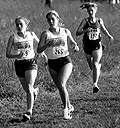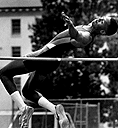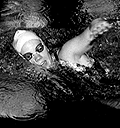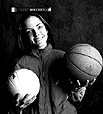




"I think our varsity program is there," says Director of Athletics and Recreation Chuck Gordon, who joined the University six years ago. "If you looked for one of the top twenty NCAA Division III programs across the board in the country [there are 340], you would look certainly at the UAA for four or five of those schools, and we would be one of them. And what's nice about us is we have the ability to be good in a number of sports. We're not putting all our eggs in men's basketball, or lacrosse, or football. We are a truly a broad-based program for men and women, and we've had success across the board, which I think speaks well for the kind of student athletes we recruit."
 Emory's decision to pursue varsity athletics more vigorously can be linked
directly to the construction of the Woodruff P.E. Center. "When I had a chance
to interview with President Laney as a finalist for this job, he asked me if I
had any questions regarding his commitment to the program," says Gordon. "And I
said I didn't because the biggest commitment he could ever make was in the
ground across campus. To spend the kind of money to provide the facility that
the University has was a clear statement on the importance that was being
placed on this program. The new baseball field was the last piece in our
existing puzzle of a facility that didn't meet the standards of the Woodruff
Center, and it is now one of the best baseball facilities in Division III."
Emory's decision to pursue varsity athletics more vigorously can be linked
directly to the construction of the Woodruff P.E. Center. "When I had a chance
to interview with President Laney as a finalist for this job, he asked me if I
had any questions regarding his commitment to the program," says Gordon. "And I
said I didn't because the biggest commitment he could ever make was in the
ground across campus. To spend the kind of money to provide the facility that
the University has was a clear statement on the importance that was being
placed on this program. The new baseball field was the last piece in our
existing puzzle of a facility that didn't meet the standards of the Woodruff
Center, and it is now one of the best baseball facilities in Division III."
Emory has not always had such a positive opinion of intercollegiate athletic competition. For much of its history the University had a strong aversion to it. According to an October 1957 article in the Emory Alumnus, "As scandal piled on top of scandal throughout the intercollegiate sports world this year and as pedagogs, press and public worriedly wondered what should be done about the whole mess, Emory took pride anew in its own system of athletics. . . . The Emory plan, more than half a century old, goes by several names, the most popular being `Athletics for All.' "
The article goes on to quote University vice president J. Gordon Stipe '07C. "Our constant aim," he said, "has been Athletics for All for the benefit of all rather than athletics for the expert few for the entertainment of the public."
In 1891, the Board of Trustees banned intercollegiate competition at Emory, and in the 1890s, to fill that void, language professor Frank Clyde Brown designed the first system of intramural athletics in America, a system that is still in use in virtually every school in this country.
The University's general opinion on intercollegiate sports was summed up in a statement of policy on athletics that was in circulation in the late 1950s: "Participation in those competitive sports [including baseball and basketball] which require elaborate and expensive facilities for public entertainment is not in accord with the educational purposes of the University."
Emory now fields teams in both of those sports, and on the surface it would appear that the University has abandoned its Athletics for All philosophy in favor of concentrating on elite athletes. Gordon says that's not true."I don't think it's really changed," he says. "We still have strong intramurals and club sport programs. Clearly we are now concentrating on increased opportunities for some elite ability athletes who happen to be students here. But I don't think we've closed the door on the Athletics for All philosophy; I think we've fine-tuned it a little bit. Before, the theory was Athletics for All, except those who were interested in varsity athletics. And now I think we've expanded the motto to include those people who want intercollegiate competition as well."
For those who don't participate in varsity athletics, the University offers a wide array of intramurals and club sports, which are extramural teams that are not governed by NCAA guidelines. "We try to offer some of the things that the varsity athletics don't," says Linda Knight, coordinator of recreational services. "If we have a varsity soccer team, we won't necessarily have a club soccer team, but we will offer it at the intramural level so people who aren't necessarily good enough to make the varsity team still have an opportunity to participate. But we don't have a varsity lacrosse team, so we have a club lacrosse team. We try and make sure that there is something out there for everyone if at all possible."
As an indication of Emory's commitment to athletic opportunities for everyone, Gordon says that when the University recently had only enough funds to light one set of fields for night play, it was decided to light the lower intramural fields, as opposed to the varsity baseball field. "It would have the most benefit for the most people," he says.
Much of Emory's recent push toward strengthening its varsity athletic teams is related to the school's membership in the UAA, which celebrates its tenth anniversary this year. The conference was founded in 1986 by a group of the nation's elite, private research institutions. Today, Emory is joined by Brandeis University, Carnegie Mellon University, Case Western Reserve University, the University of Chicago, Johns Hopkins University, New York University, the University of Rochester, and Washington University. UAA schools compete in the NCAA's Division III, which means no athletic scholarships are awarded.
According to Gordon, "In general, UAA schools promote a broad-based program and try to treat all their athletes the same. UAA schools support men's and women's programs equally and all the different sports equally. It's about real students competing for the University against like institutions. So I think we're back to where college athletics was seventy or eighty years ago."
At the heart of the UAA is the belief that "academic excellence and athletic excellence are not mutually exclusive." As an indication of just how well Emory's student athletes maintained that balance, during the spring semester of 1995, 50.7 percent of all varsity athletes were on the dean's list, as opposed to 45.2 percent of all students in the College.
 One student who especially embodied that ethic of scholarship and elite
athletic competition was Travis Saacke, who graduated from Emory College in
1995 and now works at an Atlanta investment firm. A three-time tennis
All-American and 1995 national singles tournament semi-finalist, he was also a
GTE Academic All-American. "He's a brilliant kid," says Emory tennis coach Don
Schroer. "He was one of the most complete players we've had in the past few
years, and he definitely is the role model for UAA athletics.
One student who especially embodied that ethic of scholarship and elite
athletic competition was Travis Saacke, who graduated from Emory College in
1995 and now works at an Atlanta investment firm. A three-time tennis
All-American and 1995 national singles tournament semi-finalist, he was also a
GTE Academic All-American. "He's a brilliant kid," says Emory tennis coach Don
Schroer. "He was one of the most complete players we've had in the past few
years, and he definitely is the role model for UAA athletics.
"Travis came to Emory because of the whole package. He knew he'd get a good education, and we've had some good tennis teams all along. His father is a tennis teaching professional in Louisville, and he did a nice selling job. He could see that Travis could go to the University of Kentucky, for instance, and play number six, number seven, or number eight and have a nice experience but never be a top player on a Division I team. So I think his dad did a nice job of selling him on the idea of going somewhere where he could perhaps play for a national championship rather than being a member of an average team and get an average education."
Saacke agrees he made the right decision. "Obviously Emory is a really good school and well known for its academics," he says. "But what also impressed me about Emory was that its athletics are very good, as good as a lot of Division I programs. It gave me the chance to compete on a really good team and a chance to play for a national championship."
As an athletic and academic All-American, Saacke says he knows firsthand the difficulties of excelling both on the court and in the classroom at a school where athletes receive no special privileges. "They don't cut you any slack," he says. "For example, [varsity athletes] still have to take P.E. classes. It was definitely tough. Your afternoons are tied up every day, so you're left with your evenings to study if you're not playing matches or traveling. It was definitely a tough situation, but it actually made me balance my time much more. I found I was much more productive during the season as far as getting work done for school and any other things I needed to get done."
 Sophomore Alicia Moore is another student athlete who transcends the UAA's
ethic of academic and athletic excellence. A Woodruff Scholar and pre-med
student, Moore was 1995 all-UAA honorable mention in basketball, a member of
the UAA all-conference team in volleyball in 1995, and a member of the first
Emory basketball and volleyball teams to reach the NCAA Division III national
tournament. She also set school volleyball records last season for assisted
blocks (127), total blocks (173), and blocks per game (1.32).
Sophomore Alicia Moore is another student athlete who transcends the UAA's
ethic of academic and athletic excellence. A Woodruff Scholar and pre-med
student, Moore was 1995 all-UAA honorable mention in basketball, a member of
the UAA all-conference team in volleyball in 1995, and a member of the first
Emory basketball and volleyball teams to reach the NCAA Division III national
tournament. She also set school volleyball records last season for assisted
blocks (127), total blocks (173), and blocks per game (1.32).
"Without a doubt, Alicia embodies the true scholar athlete," says Emory women's basketball coach Myra Sims. "She has excelled academically, both at the high school level and now at the college level, and has done the same thing in athletics." Because of the volleyball season, the 6'1" Moore, the Eagles' starting center this season, joined the basketball team after practices had begun. Sims says once Moore was on the court, she made an immediate impact. "Even being out there for only two or three days of practice, she's such an athlete, she runs and jumps so well, that it makes a real difference in how our team looks."
Another way to measure the strength and impact of Emory's athletic programs is to look at what some people have done after finishing their undergraduate sports careers. Recent examples include baseball standouts Jeff and Scott Kramer, who both were signed to professional contracts, and 1995 Emory College graduate Cyrus Beasley, who got his start rowing for Emory's crew club and is now ranked as the best single scull racer in the United States.
 Peter Elmore, who graduated from Oxford College in 1984 and earned his Emory
degree in economics in 1986, also used his varsity career as a springboard for
future achievements. The captain of the swim team during his senior year, in
1988 he swam the English Channel in nine hours and fifty-two minutes, setting
the eightieth fastest time on record. The following summer he placed thirteenth
at the twenty-five-mile World Championship Ocean Swim Marathon in Atlantic City.
Peter Elmore, who graduated from Oxford College in 1984 and earned his Emory
degree in economics in 1986, also used his varsity career as a springboard for
future achievements. The captain of the swim team during his senior year, in
1988 he swam the English Channel in nine hours and fifty-two minutes, setting
the eightieth fastest time on record. The following summer he placed thirteenth
at the twenty-five-mile World Championship Ocean Swim Marathon in Atlantic City.
"A great percentage of our swim team alumni have gone on to embrace the sport and continue at the masters level or still continue to set themselves challenges athletically," says Emory swim coach Peter Smith. "And that's probably a reverse correlation to a Division I experience, where a swimmer is almost happy to hang it up because they perhaps have given it their all or peaked in college. In Peter Elmore's case, we must have lit the fire inside him, and he took things to the next level after his collegiate career. I'd like to think that's a tribute to the philosophy of our program and the UAA, that we hold the challenge, the love of the sport as being very dear to an individual, and we try to nourish that instead of putting out the fire, instead of squeezing the stone dry."
Click here to return to Emory University Home Page.